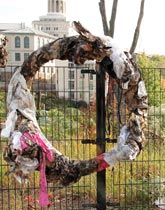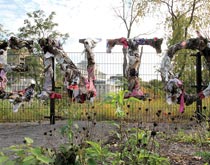Jessica Aguero (A’13) stands at the busy intersection of Forbes Avenue and Craig Street, which is about a block from the center of the Pittsburgh campus. There’s a Starbucks coffee shop on one corner and a bagel shop on another. But Aguero isn’t looking for a latte or a bite to eat. Instead, amid the belching from buses and the chattering from sidewalk commuters, she pauses for a moment to gaze at her destination, which is less than 100 yards away.
It’s a wonder there is anything of interest for her to see. Carnegie Mellon bought the plot of land that is capturing her attention. One day it will be part of the educational, research, business, and cultural Forbes Avenue corridor that the university plans to develop.

But until then, the only plan had been to raze the structure on it and leave an empty field. That empty field became an opportunity in the eyes of School of Art Professor Bob Bingham. Art Park was born, a place where students could bring art and environmental projects to the street for temporary installations.
Aguero is looking at one of those projects, a 30-foot-long installation made from everyday objects such as wood and fabric that are shaped to spell “Lo Siento,” which means “I’m sorry” in Spanish. For Aguero, the sculpture does more than speak to her. It cries out for attention because it’s her creation and requires regular maintenance so the message doesn’t get lost in litter or weeds.
“Lo Siento” isn’t an apology for Aguero, who is of Spanish descent. It’s a reflection on social problems in Latin America.

“I didn’t know how to say ‘I’m sorry’ in Spanish until I was about fifteen. My parents explained that people don’t commonly apologize in Peru. ‘Lo Siento’ exists there but is used more commonly in Central America. But, even in places where ‘Lo Siento’ does have widespread use, it connotes more ‘I’m sorry that happened to you’ or ‘I feel your loss’ rather than ‘It was my fault, forgive me.’ From my American perspective, it seems as though there would be a lot of unresolved baggage from not feeling the need to give or receive apologies. The piece’s built-up aesthetic is meant to communicate that baggage.”
As with any artwork, Aguero says, “Lo Siento” is open to interpretation by the beholder. And with each traffic backup from red lights at the Craig and Forbes intersection, there is an ever-growing audience.
—Emmitt Zitelli (HNZ’01)



